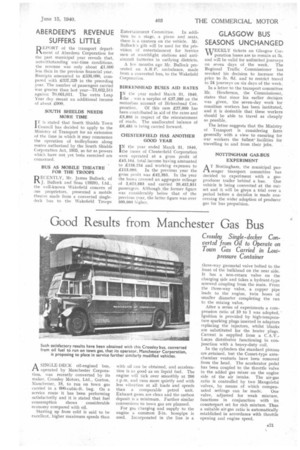Good Results from Manchester Gas Bus
Page 23

If you've noticed an error in this article please click here to report it so we can fix it.
Crossley Single-decker Convertzd from Oil to Operate on Town Gas Carried in Lowpressure Container ASINGLE-DECK oil-engined bus, operated by Manchester Corporation, was recently converted by its maker, Crossley Motors, Ltd., Gorton, Manchester, 18, to run on town gas carried in a 600-cubic-ft. bag. On a service route it has been performing satisfactorily and it is stated that fuel consumption shows considerable economy compared with oil.
Starting up from cold is said to be excellent, higher maximum speeds than with oil can be obtained, and acceleration is as good as on liquid fuel. The engine will tick over smoothly at 200 r.p.m. and runs more quietly and with less vibration at all loads and speeds than a comparable petrol unit. Exhaust gases are clean and the carbon deposit is a minimum. Further similar conversions to town gas are planned.
For gas charging and supply to the engine a common 2-in. hosepipe is used. Incorporated in the line is a three-way gunmetal valve bolted to the front of the bulkhead on the near side. It has a non-return valve on the charging side and takes a hydrant-type screwed coupling from the main. From the three-way valve, a copper pipe leads to the engine, twin hoses of smaller diameter completing the run to the mixing valve.
After a series of experiments a compression ratio of 10 to 1 was adopted. ' Ignition is provided by high-temperature sparking plugs inserted in adaptors replacing the injectors, whilst blanks are substituted for the heater plugs. Current is supplied from a C.A.V.Lucas distributor functioning in conjunction with a heavy-duty coil.
In the cylinders the standard pistons are retained, but the Comet-type antechamber venturis have been removed from the head. The accelerator pedal has been coupled to the throttle valve in the added gas mixer on the engine side of the air intake. The air-gas ratio is controlled by two Mangoletsi valves, by means of which compen sated settings can be made. One valve, adjusted for weak mixture, functions in conjunction with its counterpart set for rich mixture. Thus a suitable air-gas ratio is automatically established in accordance with throttle opening and engine speed.




















































